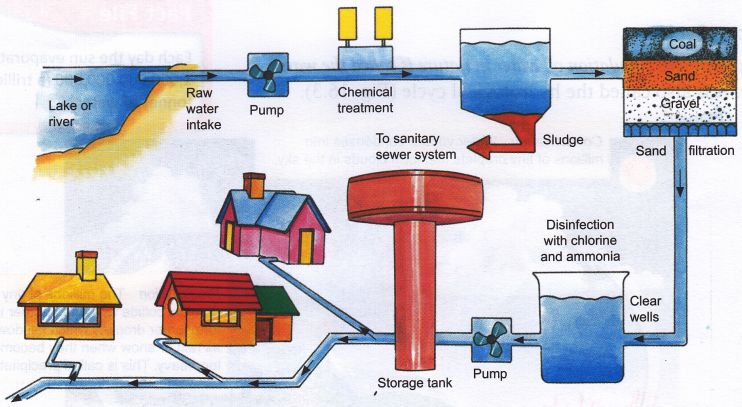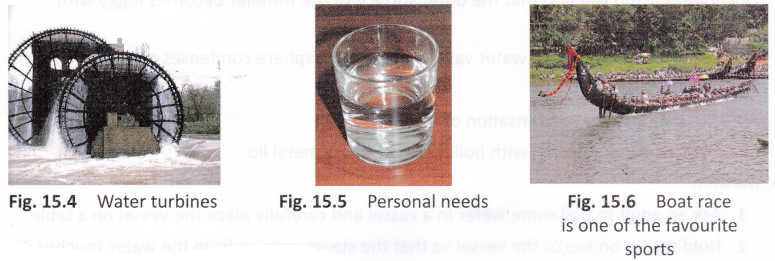Selina Concise Chemistry Class 8 ICSE Solutions – Water
ICSE SolutionsSelina ICSE SolutionsML Aggarwal Solutions
APlusTopper.com provides step by step solutions for Selina Concise ICSE Solutions for Class 8 Chemistry Chapter 8 Water. You can download the Selina Concise Chemistry ICSE Solutions for Class 8 with Free PDF download option. Selina Publishers Concise Chemistry for Class 8 ICSE Solutions all questions are solved and explained by expert teachers as per ICSE board guidelines.
Selina Class 8 Chemistry ICSE SolutionsPhysicsBiologyMathsGeographyHistory & Civics
Selina Concise ICSE Solutions for Class 8 Chemistry Chapter 8 Water
Points to Remember:
- Water is the source of life for all living beings.
- Water occurs in all the three states of matter i.e. ice, liquid water and water vapours.
- Water found in nature (i) oceans and seas (ii) rivers and lakes (iii) springs and wells (iv) rain.
- Rainwater is the purest form of water. Sea water is very impure.
- Potable water should be free from suspended impurities and harmful germs.
- Water is a compound, with the molecular formula is H2O.
- The boiling point of water is 100°C and the freezing point is 0°C.
- 0°C is also called tripple point, because water can exist in all its three states.
- The specific heat of water is higher than that of any other liquid. It is used as a cooling agent.
- Water has minimum volume and maximum density at 4°C. This is called anomalous behaviour of water.
- Water is an universal solvent. The gases dissolved in water have biological importance. They enable aquatic life to sustain itself.
- Water may be ‘hard or soft’. Hardness of water can be removed by boiling or by chemical treatment.
- Water pollution is a serious problem.
- Industrial and agriculture processes, nuclear and thermal plants pollute water.
Exercise – I
Question 1.
Name the four main sources of water.
Answer:
(i) Oceans (ii) Seas
(iii) Rivers (iv) Lakes
Question 2.
State the importance of water cycle in nature.
Answer:
(i) Water cycle helps in regulating weather on the earth.
(ii) Water cycle makes water available in various forms on the earth.
Question 3.
Why is water very precious for all living beings ?
Answer:
Water is one of the most precious substances for the existence of life. Since life on the earth began in the oceans, and since no living thing can survive without water, it is rightly called the source of life.
Water forms a large part of the body mass of all living organisms — 90% of human blood is water. Water has the ability to dissolve a number of substances. Therefore, it serve as the liquid medium in which all reactions within the living body take place.
Fruits and vegetables contain water in them. Even dry-looking substances like wood, peas, beans, grams, etc., contain some amount of water.
Question 4.
Name the two gases from which water is formed. What is the chemical composition of these two gases in water ? Give the molecular formula of water ?
Answer:
Oxygen and hydrogen
Chemical composition = H2 and O2 proportion 2:1
Molecular formula = H2O
Question 5.
What is the effect on boiling point of water when
(a) pressure is increased
(b) impurity is added
Answer:
(a) The boiling point of water increases with an increase, in pressure.
(b) Any impurity present in water lowers its freezing point and raises its boiling point.
For example, salt is added to ice to lower its melting point. Such a mixture is called a freezing-mixture. The melting is called a freezing mixture is about -15° C.
Question 6.
Give reasons:
(a) Water is used as a cooling agent
(b) Water pipes burst in severe winters.
(c) It is difficult to cook in hills compared to plains.
(d) Ice floats on water.
(e) Sea water does not freeze at 0°C.
Answer:
(a) Water has high specific heat. Water neither heats up nor cools down quickly. This property makes water as a excellent cooling agent.
(b) Water pipes bursts in severe winter because the water inside I the pipes freezes and increases its volume.
(c) Water boils at a lower temperature in the hills, where the atmospheric pressure is lower than in the plains. This is why it takes a longer time to cook in hilly regions.
(d) Ice has low density as compared to water. Water has maximum density at 4°C. That is why ice floats on water.
(e) There are impurities dissolved in sea water which increases the freezing point. That is why sea water does not freeze at 0°C.
Question 7.
How does anomalous expansion of water help aquatic organisms in cold climates ?
Answer:
The anomalous expansion of water helps in survivals of water animals in very cold climates. Initially when temperature of water falls, it becomes heavier and sinks down. This process continues till 4°C. Then after this expansion takes place. The surface layer of water gets freezed. Ice being bad conductor of heat does not allow loss of heat from the water below and results in survival of water animals.
Exercise – II
Question 1.
Explain the terms:
(a) Solution (b) Solute (c) Solvent.
Answer:
(a) Solution: “A homogeneous mixture of two or more substances can be varied is called a solution”.
(b) Solute: A substance which dissolves in a other substances to form a solution is called solute. Solute is smaller quantity in solution.
Or
“Substance which is dissolved in solvent.” is called Solute. Solute is smaller quantity in solution.
(c) Solvent: A solvent is a medium in which a solute dissolves. It is in large quantity in solution.
Solution = Solute + Solvent
Question 2.
What is meant by
(a) Unsaturated (b) Saturated and
(c) Supersaturated solutions.
Answer:
(a) Unsaturated solutions — A solution in which more of the solute can be dissolved at a given temperature is called an unsaturated solution.
(b) Saturated solutions — A solution that cannot dissolve any more of the solute at a given temperature is called a saturated solution.
(c) Supersaturated solutions — A solution that contains more solute than it can hold at room temperature is called supersaturated solution.
Question 3.
How do the solubility of a solid and a gas affected by –
(a) Increase in temperature
(b) Increase in pressure
Answer:
(a) Solubility of a solid solute generally increases with an increase in temperature. This makes it possible to prepare supersaturated solutions.
Solubility of a gas decreases with an increase in temperature.
(b) Pressure has practically no effect on the solubility of a solid (solute) in water.
In the case of gases, the amount of a gas dissolved in water increases with an increase in pressure.
Question 4.
Differentiate between:
(a) Solution and suspension
(b) Suspension and colloid
Answer:
(a) Solution and suspension
Solution
- It is an example of homogeneous mixture.
- Particle size less than 10-10m
- Transparent
- Solute particles can not be filtered. Solution pass easily through filter paper.
Suspension
- It is an example of heterogeneous mixture.
- Particle size greater team 10-7 m
- Opaque
- Particles of suspension do not pass through filter paper.
(b) Suspension and colloids
Suspension
- Heterogeneous
- Particle size greater than 10-7 m.
- Opaque.
- Particles are visible.
- Particles of suspension settle at the bottom of the container.
- Particles of suspension do not pass through filter paper.
Colloid
- Heterogeneous.
- Particles size between 10-10 to 10-7m.
- Translucent.
- Particles can be seen with the help of a powerful microscope.
- Particles of colloids do not settle.
- Colloidal particles pass easily through ordinary filter paper but do not pass through ultra filters.
Question 5.
Define: ‘water of crystallisation’. Give two examples with formulae.
Answer:
The fixed amount of water which is in loose chemical combination with a salt in its crystal is called water of crystallisation. Examples:

Question 6.
Give two examples for each of the following:
(a) Hydrated substances
(b) Crystalline anhydrous substances
(c) Drying agents
(d) Deliquescent substances
(e) Efflorescent substances
(f) Colloids
(g) Solvents other than water.
Answer:
(a) Washing soda, Glauber’s salt (Na2SO4.10H2O)
(b) Common salt (NaCl), potassium nitrate (KNO3), sugar (C12H22O111) etc.
(c) Concentrated sulphuric acid (H2SO4), phosphorus pentoxide (P2O5), quicklime (CaO)
(d) Caustic soda (NaOH), crystalline-magnesium chloride (MgCl2), calcium chloride (CaCl2), Iron (III) chloride etc.
(e) Washing soda and glauber’s salt (Na2SO4.10 H2O)
(f) Milk, blood, smoke, jellies, butter, ink etc.
(g) Acetone, ethanol, turpentive
Question 7.
What do you observe when:
(a) Blue vitriol is heated ?
(b) Washing soda is exposed to air ?
(c) Blue litmus solution is added to water ?
Answer:
(a) Blue vitriol is blue in colour as it contains 5 molecules of water of crystallisation (CuSO^HjO). When it is heated, it loses water of crystallisation and becomes an hydrous CuS04 which is grey-white in colour.
(b) Washing soda (Na2CO3.10H2O) is a white crystalline substance and on exposure to air it gets changed to white powder.
(c) Pure water is neutral to litmus which means that no change in the colour of blue or red litmus solution is observed when 1 treated with water.
Question 8.
Give reason:
(a) Silica gel pouches are kept in unused water bottles.
(b) Table salt becomes moist during rainy season.
(c) On opening a bottle of a cold drink, a fizz sound is heard.
Answer:
(a) Silica get pouches are very commonly used to absorb moisture and to keep things dry. They are often kept in unused water bottles, with camera lenses etc. to keep them dry. These pouches are ideal to reuse throughout, in places at home where there is excess of moisture.
(b) On exposure to air, table salt (NaCl) turns moist and ultimately forms a solution especially during rainy season because it contains impurities like magnesium chloride and calcium chloride which are deliquescent. Sodium chloride is not deliquescent.
(c) The cold drink bottles contain carbon dioxide and are bottled under high pressure i.e. they contain a large amount of gas dissolved in them and on opening a bottle we hear a fizz sound, this is because of the solubility of CO2 gas in it and pressure in it.
Question 9.
Give balanced chemical equations for the reaction of water with
(a) Sodium (b) Iron
(c) Carbon dioxide (d) Sodium oxide
Answer:

Question 10.
What is metal activity series ?
Answer:
The arrangement of metals in the decreasing order of their reactivity in the form of a series is called the activity or reactivity series of metals.

Question 11.
Name the gas produced when
(a) steam is passed over hot coke.
(b) chlorine is dissolved in water and exposed to sunlight
(c) a piece of calcium is added to water.
(d) when fossil fuel is burnt,
Answer:
(a) Water gas
(b) Oxygen
(c) Hydrogen
(d) Carbon dioxide
Exercise – III
Question 1.
Define:
(a) Soft water
(b) Hard water
Answer:
(a) Soft water: The water present in different natural sources has different substances dissolved in it. The water drawn from certain sources forms a lather with soap rather easily. Such water is called soft water.
(b) Hard water: Water obtained from various sources does not easily form a lather with soap, rather it forms a white sticky scum or a precipitate. This water is called hard water.
Question 2.
(a) Name the compounds responsible for
(i) temporary hardness
(ii) permanent hardness of water
(b) Suggest one method for the removal along with the reactions for
(i) temporary hardness
(ii) permanent hardness of water
Answer:
(a) (i) Temporary hard water— Water, which has . bicarbonates of calcium and magnesium dissolved in it, is temporary hard water. This kind of hardness is easily removed by boiling.
(ii) Permanent hard water— Water, which has sulphates and chlorides of calcium and magnesium dissolved in it, is called permanent hard water. This hardness cannot be removed by boiling.
(b) Removal of hardness of water:
(i) Temporary hardness—
By Boiling— This method helps to remove only the temporary hardness of water. When temporary hard water is boiled, the bicarbonates of calcium and magnesium break up to form their insoluble carbonates.
These can be filtered out so that water becomes soft

(ii) Removal of hardness of permanent hardness of water—
By Adding sodium carbonate (washing soda)
Permanent hardness of water is removed when water is treated with a small quantity of sodium carbonate.
It reacts with the soluble chlorides and sulphates of calcium and magnesium to form their insoluble carbonates. These can be removed by filtration and then the water becomes soft. Sodium sulphate or sodium chloride formed after the reaction does not affect the soap.

Question 3.
Name three water borne diseases.
Answer:
(i) Cholera (ii) Typhoid (iii) Hepatitis
Question 4.
What are the main causes of water pollution ? How can it be controlled ?
Answer:
Main causes of water pollution are:
- Chemical waste, industrial waste and agricultural processes.
- Thermal waste from nuclear and thermal power plants.
- Sewage and garbage.
Prevention of water pollution:
- Domestic sewage should be treated before being discharged into rivers.
- Using of non-biodegradable substances like detergents should be stopped.
- Trees and plants must be planted along the banks of rivers.
- Purification of water bodies should be carried out.
- The waste products of industries should be treated before they are discharged into rivers.
Question 5.
Give reasons:
(a) Alcohol is mixed with water and is used in car radiators.
(b) Icebergs float on ocean water.
(c) Carbonated drinks are bottled under high pressure.
Answer:
(a) Alcohol is mixed with the water used in car radiators to prevent it from freezing ki cold weather. Because it lowers the freezing point of water.
(b) Ice bergs float in ocean water because density of ice is less than water.
(c) Carbonated drinks are bottled under high pressure because the solubility of carbon dioxide increases with pressure.
OBJECTIVE TYPE QUESTIONS
1. Fill in the blanks:
(a) Water has maximum density and minimum volume at 4°C.
(b) Freezing mixture contains ice and salt.
(c) The solubility of a gas in water increases with rise in temperature and decreases with rise in pressure.
(d) Rain water is the purest form of natural water.
(e) Use of excessive fertilizers by farmers causes water pollution.
(f) Boiling removes the temporary hardness of water.
(g) Water turns the colour of anhydrous copper sulphate blue.
(h) Water turns the colour of anhydrous copper sulphate scum.
2. Match the statements in column A with that in column B.

3. Give one word/words for the following statements:
(a) Water fit for human consumption potable water.
(b) The harmful substances dissolved in water impurities.
(c) The change of states of water from one form to another water cycle.
(d) The gaseous form of water found in air – water vapours.
(e) A mixture of common salt and ice – freezing mixture.
(f) A substance which does not contain water anhydrous substances.
(g) A property due to which a substance absorbs water without dissolving hygroscopic.
(h) Water molecules in loose chemical combination with other substances water of crystallisation.
MULTIPLE CHOICE QUESTIONS
1. Two gases found dissolved in natural water are
(a) oxygen and carbon dioxide
(b) hydrogen and oxygen
(c) sulphur dioxide and hydrogen
(d) chlorine and ammonia
2. Temporary hardness of water can be removed by
(a) filtering
(b) boiling
(c) loading
(d) none of the above
3. The ultimate source of all water on the earth is
(a) oceans and seas
(b) spring and wells
(c) rivers and lakes
(d) rain
4. Colloids have the particle size range between
(a) 10-7 to 10-10 m
(b) 10-10 to 10-12 m
(c) 10-7 to 10-5 m
(b) 10-12 to 10-15 m
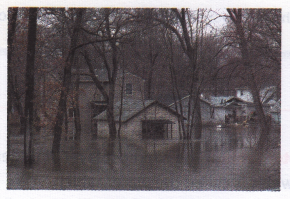

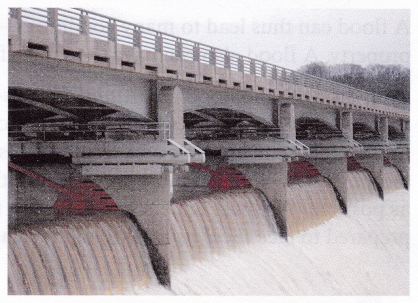
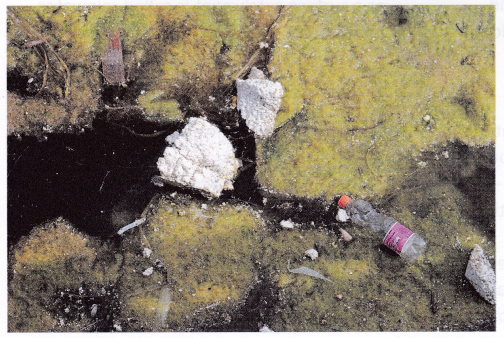
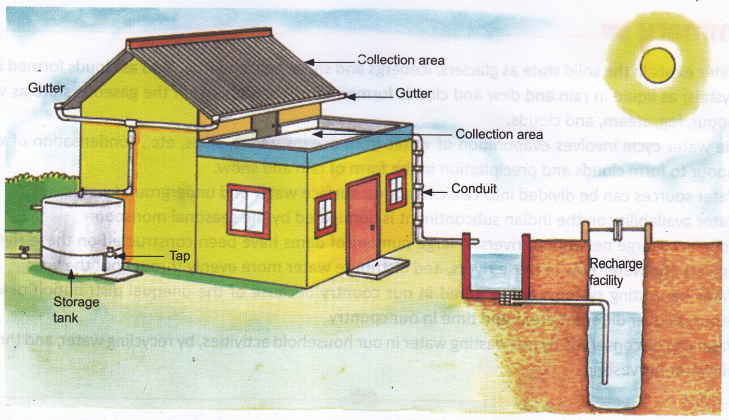

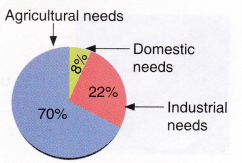
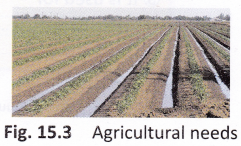 Domestic
Domestic